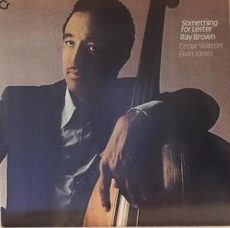
Requisites
Something For Lester ~ Ray Brown | Carl Anthony
This week I am standing in for our regular Requisites host and writer Eddie Carter, who is on an anniversary vacation. He will return next Sunday with another prolific review of an album for your collection.
This week I have selected Something for Lester, an album by bassist Ray Brown that was recorded on June 22, 23 & 24 1977 at Contemporary’s Studio in Los Angeles, California. The session was recorded in the bop and cool jazz genres and was released on the Contemporary label the following year.
The producers on the sessions were John Koenig and Lester Koenig. The photograph was taken by Bret Lopez, the design was provided by George Kershaw, with liner notes by Leonard Feather and the recording and sound was performed by the Koenig brothers and Roy DuNann.
Of the seven compositions presented here by the trio, four are classics, two are by Cedar Walton and one was composed by Brown. The conversation between the players is easy and comfortable as they navigate through each song. If you enjoy small group sessions you’ll find these consummate musicians will deliver what you like.
Tracks | 41:10
- Ojos de Rojo (Cedar Walton) – 5:16
- Slippery – 7:27 (Ray Brown)
- Something in Common (Walton) – 4:50
- Love Walked In (George Gershwin, Ira Gershwin) – 5:25
- Georgia on My Mind (Hoagy Carmichael, Stuart Gorrell) – 7:11
- Little Girl Blue (Richard Rodgers, Lorenz Hart) – 6:17
- Sister Sadie (Horace Silver) – 4:54
- Ray Brown – bass
- Cedar Walton – piano
- Elvin Jones – drums
More Posts: bass,choice,classic,collectible,collector,history,instrumental,jazz,music
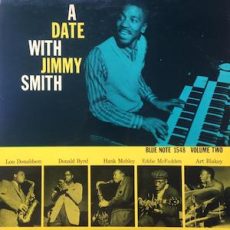
Requisites
A Date With Jimmy Smith, Volume Two ~ Jimmy Smith | By Eddie Carter
This morning’s subject brings us back to The Manhattan Towers Hotel Ballroom for A Date With Jimmy Smith, Volume Two (Blue Note BLP 1548/BST 81548). Jimmy Smith was an accomplished pianist who began playing the organ at the age of twenty-eight. He made the instrument popular for jazz improvisation and would lead me to discover the other organists who followed him. Joining the organist again are Donald Byrd (tracks: A1, B2) on trumpet, Lou Donaldson (tracks: A1, B1, B2) on alto sax, Hank Mobley (tracks: A1, B2) on tenor sax, Eddie McFadden (tracks: A1, B2) on guitar, and Art Blakey (tracks: A1, B2) on drums. The copy used in this report is a friend’s 1984 Toshiba-EMI Limited Japanese Mono reissue sharing the original catalog number.
Side One is occupied by an extended version of I Let A Song Go Out Of My Heart by Duke Ellington, Irving Mills, Henry Nemo, and John Redmond. The rhythm section swings easily into the melody stated by Lou. Donald sets the pace with a relaxed attitude on the first solo, next Hank gives a cheerfully buoyant reading. Eddie follows with a simple, bluesy statement, then Lou brings a good deal of enthusiasm to his interpretation. Jimmy is just a pleasure in the finale leading to Lou’s closing chorus and Jimmy’s ending. Side Two opens with I’m Getting Sentimental Over You by George Bassman and Ned Washington. This is a duet by Donaldson and Smith who embrace the jazz standard with elegant simplicity on the melody and during two touching interpretations before a pretty finale.
Hank Mobley’s Groovy Date is a blowing session that coaxes everyone to great heights and allows each member a chance to shine. Lou wastes no time getting down to business on the first solo, then Donald takes us on an eventful ride. Hank makes an indelible imprint on the third interpretation. Eddie responds with a spirited contribution and Jimmy offers a zestful joy on the next reading. Art gets the last word in a lively conversation with the front line into the close. A Date With Jimmy Smith, Volume Two was produced by Alfred Lion and the man behind the dials was Rudy Van Gelder. This Toshiba-EMI reissue is a wonderful recording with an impressive soundstage that brings the group to your listening room with superb definition. If you’re a fan of jazz organ, make A Date With Jimmy Smith, Volume Two on your next vinyl hunt. Like its companion, it’s a solid album with a superb ensemble that gives a glimpse into what was to come from Jimmy Smith in the next few years!
~ A Date With Jimmy Smith, Volume One (Blue Note BLP 1547/BST 81547) – Source: Discogs.com ~ I Let a Song Go Out of My Heart, I’m Getting Sentimental Over You – Source: JazzStandards.com © 2022 by Edward Thomas Carter
More Posts: choice,classic,collectible,collector,history,instrumental,jazz,music,organ
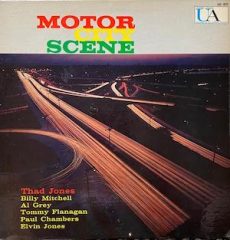
Requisites
Motor City Scene ~ Thad Jones Sextet | By Eddie Carter
This morning’s record submitted for your consideration is Motor City Scene (United Artists UAL 4025/UAS 5025) by The Thad Jones Sextet. It hit the stores in 1959 and consists of tunes composed by the leader. Thad comes from a musical family; both his brothers were excellent musicians. His older brother Hank was a consummate pianist, and his younger brother Elvin was a dynamic drummer whose birthday was recently observed on September 9. The ensemble is Thad Jones on cornet (tracks: A1, B1, B2), and flugelhorn (track: A2), Al Grey on trombone, Billy Mitchell on tenor sax, Tommy Flanagan on piano, Paul Chambers on bass, and Elvin Jones on drums. The copy used in this report is a friend’s US original Mono deep groove album.
Side One gets underway with Let’s Play One, an easy-going blues that Tommy opens with a brief introduction that evolves into the sextet’s collective theme. Tommy starts the solos with a relaxing presentation, next Al comes in for a laid-back statement. Billy steps up next to give a marvelous reading, then Thad contributes a very pleasant presentation. Paul walks leisurely into the finale preceding the ensemble’s finish. Minor on Top picks up the pace gradually on the group’s lightly-swinging melody. Thad leads off with a charming flugelhorn statement, then Billy hits a relaxed groove on the next solo. Paul constructs a delicious bass performance next. Al delivers the next reading with absolute assurance, followed by Tommy and Elvin who share an attractive exchange into the closing chorus.
Like Old Times takes the tempo up a few notches to start Side Two with the front line leading a brisk melody. Billy takes the lead this time with a swinging solo. Tommy says his piece next in a rollicking reading. Al romps through a lively presentation next. Elvin makes a brief appearance, followed by Paul who puts together a passionate performance. Thad gets the last word and cooks on muted cornet leading to the sextet’s ending. No Refill begins with a soft introduction by Elvin segueing into the sextet’s soothing opening chorus. Thad’s first solo on muted cornet is restrained in its mood of gentle warmth and graciousness. Billy handles the second statement discreetly, and Tommy adds the exclamation point with a thoughtful performance ahead of the sextet’s ending theme and slowly fades into silence.
Motor City Scene was produced by Tom Wilson, and the man behind the dials was Lewis Merritt. I was impressed with the sound quality of the recording. The album has a superb soundstage with vivid sonics. The instruments emerge from your speakers as if the sextet’s playing in front of your favorite chair and the record is quiet for its age. Thad and his colleagues are in excellent form throughout, and this album highlights Thad’s ability as a composer. If you’re a Hard-Bop fan, I invite you to check out Motor City Scene by The Thad Jones Sextet, the next time you’re out shopping for records. It may be hard to find, as the few LPs I’ve seen online are already at collector’s prices, but your diligence will be rewarded with a great album for your library that’s highly recommended!
© 2022 by Edward Thomas Carter
More Posts: choice,classic,collectible,collector,cornet,history,instrumental,jazz,music
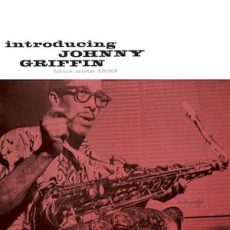
Requisites
Introducing Johnny Griffin ~ Johnny Griffin | By Eddie Carter
Submitted for your approval this morning is the 1956 debut by tenor saxophonist, Johnny Griffin. Introducing Johnny Griffin aka Chicago Calling (Blue Note BLP 1533/BST 81533) is the first of three releases he made as a leader for Alfred Lion’s label. The other two are A Blowing Session (1957) and The Congregation (1958). Johnny was nicknamed The Little Giant for his small size, but he possessed a robust sound and dazzling technique that kept him recording and in demand as a leader and sideman for over sixty years. For his first album, Griff’s working with three of the best musicians in the business, Wynton Kelly on piano, Curly Russell on bass, and Max Roach on drums. My copy used in this report is the 2002 Classic Records Mono audiophile deep groove reissue sharing the original catalog number.
Side One opens briskly with Mil Dew, the first of three tunes by Johnny Griffin. Max begins the fireworks with a brief introduction. Johnny grips you right away from a fast-moving opening chorus and a wild ride on the first solo. Wynton stokes the fire with fierce heat next, then Max aggressively exchanges notes with Griff ahead of Curly’s vigorous comment during the closing chorus. Chicago Calling, also by the leader, is listed as the album’s title tune and the quintet begins the melody in a relaxed groove. Johnny eases into the opening statement leisurely, then takes the tempo up for the remainder of his reading. Wynton meets the challenge with a nimble solo that’s absolutely stunning; next Griff returns with a delightfully carefree interpretation leading to the climax.
These Foolish Things by Harry Link, Eric Maschwitz (using the pseudonym Holt Marvell), and Jack Strachey made its debut in the British musical comedy, Spread It Abroad (1936). Wynton introduces the song tenderly, segueing into a heart-warming opening chorus and lead solo by Griff. Kelly delivers a delicate interpretation that’s beautifully constructed to match Russell and Roach’s sultry support preceding Johnny’s beautiful finale. The Boy Next Door by Ralph Blaine and Hugh Martin begins with a light-hearted theme by the quartet. Griff opens the solos expressing great joy on the first interpretation. Wynton steps up next with a very satisfying performance. Griff swings soulfully for a few more verses before the foursome reassembles for the ending.
Side Two starts with the group inviting us to get comfortable and enjoy a breezy blues by Griffin that’s Nice and Easy. The saxophonist takes the listener to a notably relaxed atmosphere on the melody and opening statement. Wynton offers a carefree interpretation that’s just right, followed by Curly who gives a delightfully mellow performance into the ensemble’s finale. It’s All Right With Me by Cole Porter takes off at a blistering pace from the quartet’s opening chorus into Griffin’s ferociously speedy first flight that ascends to a peak of intensity. Kelly continues soaring into the stratosphere with equally explosive verses, then Griff comes back with a few final fiery choruses leading to the melody’s reprise and abrupt conclusion.
Lover Man by Jimmy Davis, Roger Ramirez, and James Sherman opens with a sensitive introduction by Kelly that blossoms into Johnny’s hauntingly beautiful melody. Griff swings gently on the opening solo, then Wynton enhances the song’s intimacy with a lovely reading. Johnny adds a few tenderly expressed thoughts into the close.
Introducing Johnny Griffin was remastered by Bernie Grundman who knocks it out of the park with a breathtaking soundstage from Rudy Van Gelder’s original tapes. The highs sparkle, the midrange is clean and crisp, and the bass is deep. The album is pressed on 200 grams of Quiex SV-P Super Vinyl and is quiet until the music starts. If you’re a fan of tenor sax or are new to the music of Johnny Griffin, I highly recommend Introducing Johnny Griffin for a spot in your library. It’s a great album for anyone who loves jazz that gets better with repeated listening!
~ A Blowing Session (Blue Note BLP 1559), The Congregation (Blue Note BLP 1580) – Source: Discogs.com ~ These Foolish Things, Lover Man – Source: JazzStandards.com ~ The Boy Next Door – Source: Wikipedia.org © 2022 by Edward Thomas Carter
More Posts: choice,classic,collectible,collector,history,instrumental,jazz,music,saxophone
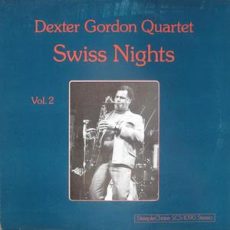
Requisites
Swiss Nights, Vol. 2 ~ Dexter Gordon Quartet | By Eddie Carter
I begin September with a return to The Zürich Jazz Festival ’75 for this morning’s discussion of Swiss Nights, Vol. 2 (SteepleChase Records SCS-1090) by The Dexter Gordon Quartet. The tenor saxophonist’s back on stage with Kenny Drew on piano, Niels-Henning Ørsted Pedersen on bass, and Alex Riel on drums. My copy used in this report is the 1978 SteepleChase Records German Stereo Audiophile release.
Dexter opens the set introducing There’s No Greater Love by Isham Jones and Marty Symes. The quartet launches into an exciting melody, stepping aside for Dexter who leads off the first solo vigorously. Kenny shows off his creative powers in the second reading, next Niels-Henning walks the bass enthusiastically. Dexter trades thoughts with Alex leading to his final solo ahead of the reprise and finish.
Sticky Wicket, the first of two tunes by Dexter eases the throttle back to a comfortable pace on the foursome’s opening chorus. Gordon leads off the solos with a relaxed statement. Drew continues cruising to a carefree beat, then Pedersen takes a laid-back stroll with his bass. Gordon and Riel share a brief exchange preceding the reprise and the audience’s approval.
Side Two opens to a timeless standard from The Great American Songbook, Darn That Dream by Jimmy Van Heusen and Eddie Lange. Dexter and the trio introduce the song with a delicately gentle theme. Dexter’s tenor sax is the epitome of graceful elegance on the opening solo, next Kenny compliments him with a mellow reading of soft warmth. Niels-Henning and Alex hold everything together as Dexter returns for the climax.
Montmartre is Dexter Gordon’s tribute to the Copenhagen jazz club and is off to the races from the foursome’s opening theme. The leader kicks off the solos with a robust performance that gains momentum as it unfolds. Drew has a very good time on the second statement, next Gordon and Riel exchange a few ideas, then the drummer gets the spotlight briefly. The quartet returns to take the song out with an abrupt finish, followed by the group’s theme and musician introductions to great applause.
Nils Winther produced Swiss Nights, Vol. 2, and Helmuth Kolbe recorded and mixed the album. The soundstage is excellent, placing the listener in a front row seat to enjoy the quartet at work. The record is pressed on 180 grams of audiophile vinyl and is very quiet until the music starts. Like its two companions, Swiss Nights, Vol. 2 is a great live album by The Dexter Gordon Quartet with tight musicianship and outstanding sound. If you’re a fan of Dexter Gordon, it’s definitely worth adding to your library!
~ Swiss Nights, Vol. 1 (SteepleChase Records SCS-1050), Swiss Nights, Vol. 3 (SteepleChase Records SCS-1110) – Source: Discogs.com ~ There’s No Greater Love, Darn That Dream – Source: JazzStandards.com © 2022 by Edward Thomas Carter
More Posts: choice,classic,collectible,collector,history,instrumental,jazz,music,saxophone


